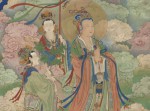The Japanese artist Kawase Hasui (1883 – 1957) was born in the Shiba ward of Tokyo. The Kawase family’s fourth child and first son, Hasui nearly did not become an artist. He was not only expected to take over the family business but also rebuffed in his later attempt to join the atelier of painter Kaburagi Kiyokata (1878 – 1973). At age twenty-five, Hasui was thought to be too old to begin artistic studies. After two years and several attempts, however, he was finally accepted into Kaburagi’s studio.
During his early years, Hasui worked primarily as a commercial illustrator for magazines and advertisements. His career path changed in 1918 when he saw an exhibition of prints by Ito Shinsui and was inspired to create prints of his own. That same year, Hasui’s first experimental prints were published by Watanabe Shozaburo, initiating a relationship that would last for the rest of Hasui’s life.
Watanabe named the prints created by Hasui and others shin-hanga, meaning “new prints.” By bringing together the talents of an artist, a block carver, a printer or block colorist, and a publisher, shin-hanga works mimicked the traditional collaborative process of ukiyo-e printmaking. However, the sensibility of this new style was very different from ukiyo-e: instead of the flat, stylized planes typical in ukiyo-e, shin-hanga incorporated aspects of Western draftsmanship and printmaking, including perspective and volumetric shading.
This exhibition features fifteen woodblock color prints by Hasui, selected from more than 320 Hasui prints donated to VMFA by René and Carolyn Balcer in 2006. These works, which focus on the season of spring, celebrate new life and nature’s renewal and symbolize hopefulness for a prosperous year.
From the Collection
Kawase Hasui, Yudaki Falls, Nikko (Nikko Yudaki), 1941
Kawase Hasui, Spring Evening at the Tosho Shrine, Ueno (Haru no yu [Ueno Toshogu]), 1948
Event Has Concluded
East Asian Galleries Open this Month
Posted on September 12, 2012
On September 20, VMFA will celebrate the public opening of the new East Asian art galleries. The East Asian suite –... Read more


